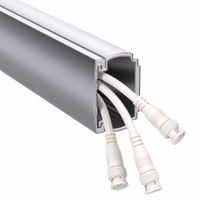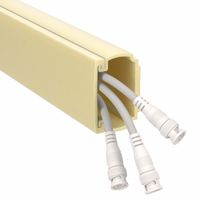Call +(254) 703 030 000 / 751 483 999 / 721 704 777
- Home
- Electrical
- Wire Cable Management
- Surface Raceways Cable Concealers
- Single Channel Surface Raceways
.....Read More
Frequently Asked Questions
What are the benefits of using surface raceways for cable management?
Surface raceways offer several benefits for cable management:
1. **Aesthetic Appeal**: Surface raceways provide a neat and organized appearance by concealing cables, which enhances the overall aesthetics of a space.
2. **Easy Installation**: They are relatively easy to install on existing walls without the need for extensive construction work, making them ideal for retrofitting in older buildings.
3. **Flexibility**: Surface raceways can be easily modified or expanded to accommodate additional cables, allowing for flexibility in dynamic environments where technology needs may change.
4. **Protection**: They protect cables from physical damage, dust, and moisture, which can extend the lifespan of the cables and improve safety.
5. **Accessibility**: Surface raceways allow for easy access to cables for maintenance, repairs, or upgrades, reducing downtime and labor costs.
6. **Cost-Effective**: Compared to in-wall wiring, surface raceways are a cost-effective solution as they require less labor and materials for installation.
7. **Compliance**: They help in maintaining compliance with building codes and standards by organizing and securing cables properly.
8. **Versatility**: Available in various sizes, shapes, and materials, surface raceways can be tailored to suit different environments and specific cable management needs.
9. **Safety**: By organizing and securing cables, surface raceways reduce tripping hazards and the risk of electrical fires.
10. **Minimal Disruption**: Installation of surface raceways causes minimal disruption to the existing infrastructure, making them suitable for occupied spaces.
Overall, surface raceways provide a practical, efficient, and aesthetically pleasing solution for managing cables in both residential and commercial settings.
How do you install surface raceways on walls and ceilings?
1. **Plan the Layout**: Determine the path for the raceway, considering the shortest and most efficient route. Mark the path on the wall or ceiling using a pencil or chalk line.
2. **Measure and Cut**: Measure the required length of the raceway. Use a hacksaw or a specialized raceway cutter to cut the raceway to the desired length.
3. **Prepare the Surface**: Clean the wall or ceiling surface to ensure proper adhesion. Remove any dust, dirt, or grease.
4. **Install Base**: If the raceway has a base and cover design, start by installing the base. Use adhesive backing if available, or drill holes and use screws to secure the base to the wall or ceiling. Ensure it is level and aligned with your markings.
5. **Install Fittings**: Attach any necessary fittings such as elbows, tees, or couplings at corners or junctions. Secure them according to the manufacturer's instructions.
6. **Insert Cables**: Run the cables or wires through the raceway. Ensure they are neatly arranged and not twisted or kinked.
7. **Secure the Cover**: Snap or slide the cover onto the base, ensuring it is securely fastened. Some covers may require screws or clips for additional security.
8. **Check Alignment**: Ensure the raceway is straight and properly aligned. Make any necessary adjustments.
9. **Finish and Inspect**: Inspect the installation for any gaps or loose sections. Make sure all components are securely fastened and the installation meets local electrical codes.
10. **Test**: If applicable, test the electrical connections to ensure everything is functioning correctly.
11. **Clean Up**: Remove any debris or tools from the work area.
What materials are surface raceways made from?
Surface raceways are typically made from the following materials:
1. **PVC (Polyvinyl Chloride):** This is the most common material used for surface raceways due to its affordability, ease of installation, and good insulating properties. PVC raceways are lightweight, resistant to moisture and chemicals, and provide a clean, professional appearance.
2. **Metal (Aluminum or Steel):** Metal raceways, often made from aluminum or steel, offer enhanced durability and protection against physical damage. They are suitable for environments where additional strength is required, such as industrial settings. Metal raceways also provide excellent electromagnetic interference (EMI) shielding.
3. **Fiberglass:** Fiberglass raceways are used in environments where high resistance to heat and corrosion is necessary. They are non-conductive and can withstand harsh conditions, making them suitable for specific industrial applications.
4. **ABS (Acrylonitrile Butadiene Styrene):** ABS is a thermoplastic material known for its toughness and impact resistance. It is used in raceways that require a balance between strength and flexibility.
5. **Polycarbonate:** This material is used for raceways that need to be transparent or translucent. Polycarbonate raceways are strong, impact-resistant, and can withstand high temperatures.
6. **Composite Materials:** Some raceways are made from composite materials that combine the properties of different substances to achieve specific performance characteristics, such as enhanced strength or flexibility.
Each material offers distinct advantages depending on the application, environmental conditions, and specific requirements of the installation.
Can surface raceways be used outdoors?
Yes, surface raceways can be used outdoors, but specific conditions and requirements must be met to ensure safety and compliance with electrical codes. When selecting a surface raceway for outdoor use, it is crucial to choose products specifically designed and rated for exterior environments. These raceways should be made from materials that are resistant to UV radiation, moisture, temperature fluctuations, and other environmental factors.
Outdoor-rated raceways are typically constructed from durable materials such as PVC or metal with protective coatings to prevent corrosion. They must also have appropriate sealing to prevent water ingress, which could lead to electrical hazards. The National Electrical Code (NEC) and local building codes provide guidelines on the installation of raceways outdoors, including requirements for weatherproofing and grounding.
Additionally, the installation process must ensure that all connections and joints are properly sealed and that the raceway is securely mounted to withstand wind and other physical stresses. It is also important to consider the expansion and contraction of materials due to temperature changes, which can affect the integrity of the raceway over time.
In summary, while surface raceways can be used outdoors, it is essential to select the right type of raceway and follow all relevant codes and installation practices to ensure a safe and durable electrical system.
How do you choose between metallic and nonmetallic raceways?
When choosing between metallic and nonmetallic raceways, consider the following factors:
1. **Environment**:
- **Metallic Raceways**: Suitable for environments where mechanical protection is crucial, such as industrial settings. They offer better resistance to physical damage.
- **Nonmetallic Raceways**: Ideal for corrosive environments or where moisture is present, as they resist rust and corrosion.
2. **Cost**:
- **Metallic Raceways**: Generally more expensive due to material and installation costs.
- **Nonmetallic Raceways**: Typically more cost-effective, especially in large installations.
3. **Installation**:
- **Metallic Raceways**: Require more labor-intensive installation, often needing special tools and fittings.
- **Nonmetallic Raceways**: Easier and quicker to install, often with snap-together components.
4. **Electrical Conductivity**:
- **Metallic Raceways**: Conduct electricity, which can be advantageous for grounding but may require additional considerations for electrical safety.
- **Nonmetallic Raceways**: Non-conductive, reducing the risk of electrical hazards.
5. **Thermal Expansion**:
- **Metallic Raceways**: Less prone to expansion and contraction with temperature changes.
- **Nonmetallic Raceways**: More susceptible to thermal expansion, which can affect long-term performance.
6. **Aesthetics**:
- **Metallic Raceways**: Often preferred for visible installations due to their sleek appearance.
- **Nonmetallic Raceways**: Available in various colors and finishes, offering more design flexibility.
7. **Regulatory Compliance**:
- Ensure compliance with local building codes and standards, which may dictate the type of raceway based on application and location.
8. **Fire Resistance**:
- **Metallic Raceways**: Generally offer better fire resistance.
- **Nonmetallic Raceways**: May require additional fireproofing measures.
Evaluate these factors based on the specific requirements of your project to make an informed decision.
Are surface raceways suitable for high-traffic areas?
Surface raceways can be suitable for high-traffic areas, but their appropriateness depends on several factors. Surface raceways are designed to enclose and protect electrical wiring, data cables, and other types of cabling. They are typically mounted on walls or ceilings, providing a neat and organized way to manage cables without the need for in-wall installation.
In high-traffic areas, the durability and material of the raceway are crucial. Metal raceways, for example, offer greater protection against physical damage compared to plastic ones. They are more resistant to impacts and can withstand the wear and tear associated with frequent foot traffic or equipment movement.
The installation method also plays a significant role. Surface raceways should be securely fastened to prevent dislodging or damage. In areas where they might be subject to frequent contact, additional protective measures, such as corner guards or reinforced covers, can enhance their durability.
Aesthetic considerations are important in high-traffic areas, especially in commercial or public spaces. Surface raceways should blend with the environment to maintain a professional appearance. Many raceways come in various colors and finishes, allowing them to match the decor.
Compliance with safety standards and building codes is essential. Surface raceways must be installed according to local regulations to ensure they do not pose a tripping hazard or obstruct emergency exits.
In summary, while surface raceways can be suitable for high-traffic areas, their success depends on choosing the right materials, ensuring secure installation, considering aesthetic integration, and adhering to safety standards. Proper planning and execution can make them a viable solution for cable management in such environments.
What types of cables can be housed in surface raceways?
Surface raceways can house a variety of cable types, including:
1. **Power Cables**: These include electrical cables used for supplying power to outlets, lighting fixtures, and other electrical devices. They are typically insulated to handle the voltage and current requirements.
2. **Data Cables**: Commonly used for networking purposes, these include Ethernet cables (such as Cat5e, Cat6, and Cat6a) that facilitate data transmission for internet and local area networks.
3. **Telecommunication Cables**: These include telephone cables and other communication lines that connect telephones and other communication devices.
4. **Coaxial Cables**: Used primarily for cable television and internet connections, coaxial cables can also be housed in surface raceways to protect them and maintain a neat appearance.
5. **Fiber Optic Cables**: These cables are used for high-speed data transmission and can be housed in raceways to protect the delicate fibers from damage.
6. **Audio/Video Cables**: These include HDMI, RCA, and speaker wires used in home theater systems and other audio/video setups.
7. **Control and Signal Cables**: Used in industrial and commercial settings, these cables transmit control signals and data between devices and systems.
8. **Security and Alarm Cables**: These cables connect security cameras, alarm systems, and other security devices.
Surface raceways provide a protective and organized pathway for these cables, ensuring safety and aesthetics in residential, commercial, and industrial environments.

